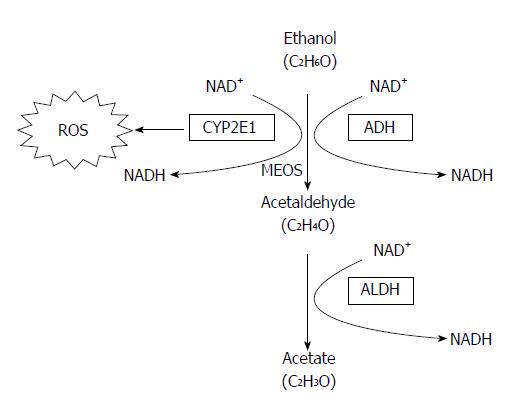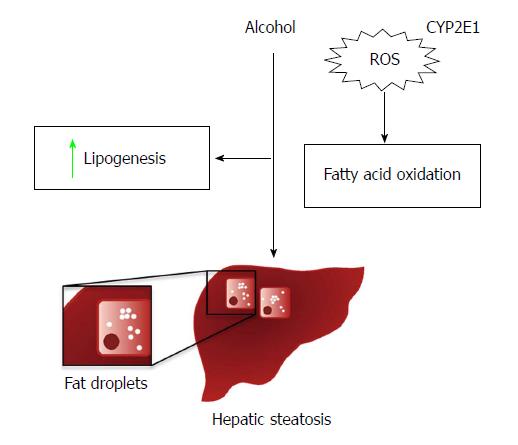Copyright
©The Author(s) 2018.
World J Gastroenterol. Dec 7, 2018; 24(45): 5063-5075
Published online Dec 7, 2018. doi: 10.3748/wjg.v24.i45.5063
Published online Dec 7, 2018. doi: 10.3748/wjg.v24.i45.5063
Figure 1 Alcohol metabolism in hepatocytes.
Ethanol is oxidized to acetaldehyde through action of the enzyme alcohol dehydrogenase and cytochrome P450 isoenzyme 2E1 a major component of the microsomal enzyme oxidation system. Acetaldehyde is subsequently metabolized to acetate by acetaldehyde dehydrogenase. In this process coenzyme nicotinamide adenine dinucleotide is reduced to coenzyme nicotinamide adenine dinucleotide reduced. The metabolism of ethanol increases generation of reactive oxygen species, including hydroxyethyl, superoxide anion and hydroxyl radicals, which contribute to oxidative stress and also can react with other cellular molecules, forming adducts (proteins, lipids or DNA). ADH: Alcohol dehydrogenase; CYP2E1: Cytochrome P450 isoenzyme 2E1; MEOS: Microsomal enzyme oxidation system; ALDH: Acetaldehyde dehydrogenase; NAD+: Nicotinamide adenine dinucleotide; NADH: Nicotinamide adenine dinucleotide reduced; ROS: Reactive oxygen species.
Figure 2 Alcohol induces fatty liver disease.
Alcohol causes the accumulation of fat droplets in hepatocytes increasing the lipogenesis and decreasing the fatty acid oxidation. CYP2E1: Cytochrome P450 isoenzyme 2E1; ROS: Reactive oxygen species.
- Citation: Lamas-Paz A, Hao F, Nelson LJ, Vázquez MT, Canals S, Gómez del Moral M, Martínez-Naves E, Nevzorova YA, Cubero FJ. Alcoholic liver disease: Utility of animal models. World J Gastroenterol 2018; 24(45): 5063-5075
- URL: https://www.wjgnet.com/1007-9327/full/v24/i45/5063.htm
- DOI: https://dx.doi.org/10.3748/wjg.v24.i45.5063










